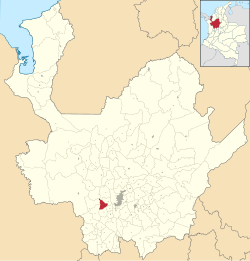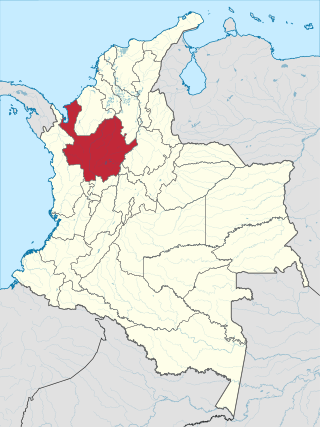
Antioquia is one of the 32 departments of Colombia, located in the central northwestern part of Colombia with a narrow section that borders the Caribbean Sea. Most of its territory is mountainous with some valleys, much of which is part of the Andes mountain range. Antioquia has been part of many territorial divisions of former countries created within the present-day territory of Colombia. Prior to adoption of the Colombian Constitution of 1886, Antioquia State had its own sovereign government.
Armenia is a country in the South Caucasus region of Eurasia.

Quindío is a department of Colombia. It's located in the western central of the country, specifically in the Andean region. Its capital is Armenia. It's famous for the quality of the coffee plantations, colorful architecture, benign weather, variety of hotel accommodations and tourist landmarks. This department is located in a strategic area, in the center of the triangle formed by the three main cities of the country: Bogotá, Medellín and Cali. Quindío is the second-smallest Colombian department with 12 municipalities. Ethnographically and culturally, it belongs to the Paisa region.

Armenia is the capital of Quindío Department in the South American country of Colombia. Armenia is a medium-sized city and part of the "coffee axis" along with Pereira and Manizales. It's one of the main centers of the national economy and of the Colombian coffee growing axis. As a result, the historic center of Armenia was named as part of the "Coffee Cultural Landscape" of UNESCO World Heritage Site in 2011.

A Paisa is someone from a region in the northwest of Colombia, including part of the West and Central cordilleras of the Andes in Colombia. The Paisa region is formed by the departments of Antioquia, Caldas, Risaralda and Quindío. Some regions of Valle del Cauca Department (north) and Tolima Department (west) culturally identify as paisas. The main cities of the Paisa region are Medellín, Pereira, Manizales and Armenia.

Ebéjico is a town and municipality in the West of Antioquia Department, Colombia. The population was 10,338 at the 2018 census.

Caracol Radio is one of the main radio networks in Colombia. Founded in Medellín in 1948 when La Voz de Antioquia station acquired the 50% of Emisoras Nuevo Mundo, based in Bogotá.
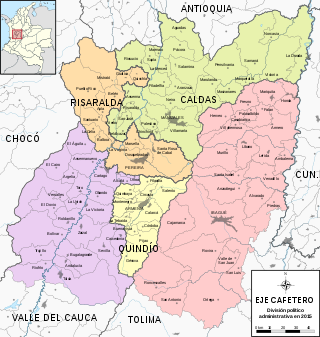
The Colombian coffee region, also known as the Coffee Triangle is a part of the Paisa region in the rural area of Colombia. It is famous for growing and producing the majority of Colombian coffee. There are four departments in the area: Caldas, Quindío, Risaralda and Tolima. The most visited cities are Manizales, Armenia, Pereira, and Ibagué.

The Colombia national rugby union team is classified as a tier three nation by World Rugby. They have thus far not qualified for a Rugby World Cup, but have participated in qualifying tournaments. Colombia made their debut against Mexico in 1996. In 2018, the Colombians won their first significant international honour, winning the inaugural Americas Rugby Challenge, the 'B' championship to the Americas Rugby Championship.
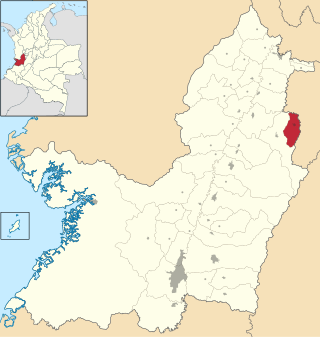
Caicedonia is a town and municipality located in the Department of Valle del Cauca, Colombia, situated about 172 km from the capital Cali. Founded in 1910 by Daniel Gutierrez, Juan Bautista Angely and a group of settlers from Antioquia, Caldas, and Tolima, it was named after Lisandro Caicedo and became a municipality in 1923. Mostly mountainous, its economy is based on agriculture and commerce, its main exports are corn, coffee, sugarcane and bananas. Given its location on the border with the Quindío Department, only 35 km from that department's capital, Armenia, Caicedonia belongs ethnographically and culturally to the Paisa region.
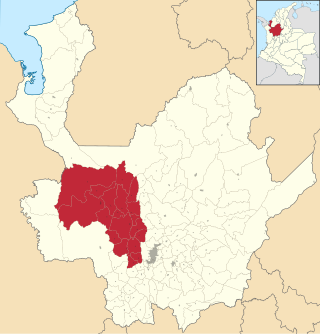
Western Antioquia is a subregion in the Colombian Department of Antioquia. The region is made up by 18 municipalities.
Rodrigo Arenas Betancourt was a Colombian sculptor. At the time of his death in 1995 he was recognized as one of the most important sculptors in Colombia and Latin America. Most of the major cities in Colombia have statues sculpted by Arenas Betancourt.

The Roman Catholic Archdiocese of Medellín is an archdiocese located in the city of Medellín in Colombia.
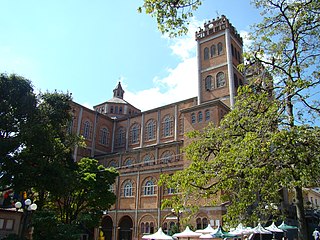
The Diocese of Jericó is a Latin Church ecclesiastical territory or diocese of the Catholic Church in Western Colombia. It is a suffragan diocese in the ecclesiastical province of the metropolitan Archdiocese of Medellín.

Empresas Públicas de Medellín (EPM) was established on 18 November 1955 as a residential public utilities company which, initially, only served the inhabitants of Medellin, Colombia its hometown.
ADA S.A., operating as Aerolínea de Antioquia (ADA), was a regional airline headquartered at the Olaya Herrera Airport in Medellín, Colombia. It started operations in 1987. It ceased all operations on March 29, 2019. At its peak, the airline operated scheduled domestic services from Medellín to over 20 destinations. Its main base was in Olaya Herrera Airport.

Exposiciones is the thirteenth station on line A of the Medellín Metro from north to south. The station is located in the south-central area of Medellín in Colombia. It is named after the Plaza Mayor Conventions and Exhibitions center, and it is the first station on lina A that is not next to the Medellín River. The station was opened on 30 November 1995 as part of the inaugural section of Line A, from Niquía to Poblado.
Colombia Migration is Colombia's border control agency responsible for monitoring and conducting migratory control within the framework of national sovereignty and in accordance with the law.
The Romeral Fault System is a megaregional system of major parallel and anastomosing faults in the Central Ranges of the Colombian Andes and the Cauca, Amagá, and Sinú-San Jacinto Basins. The system spans across ten departments of Colombia, from northeast to south Bolívar, Sucre, Córdoba, Antioquia, Caldas, Risaralda, Quindío, Valle del Cauca, Cauca and Nariño. The fault zone extends into Ecuador where it is known as the Peltetec Fault System. The in detail described part of the Romeral Fault System south of Córdoba has a total length of 697.4 kilometres (433.3 mi) with a cumulative length of 1,787.9 kilometres (1,110.9 mi) and runs along an average north to south strike of 017.6 ± 16, cross-cutting the central-western portion of Colombia.

